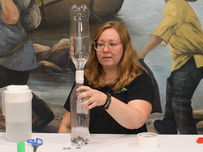top of page
Try it!


Dig then devour in this archeology activity
Check out this sweet activity to learn how archaeologists dig into the earth to learn about the past.


How do bugs walk on water? See for yourself
If you’ve visited a river or a lake recently, you might have seen some insects in the water. If you took a second look, you might have noticed that some bugs sit on the water. How does that happen?! See for yourself with this experiment.


See weather in action with DIY tornado
A person sitting at a table holding up two 2-liter soda bottles connected at their openings to form a tornado model.


Spin into summer with fun pinwheel craft
Make a fun, colorful pinwheel using paper, scissors, a tack, and a straw or pencil. Cut a square, mark the center, draw and cut lines from corners to the middle, fold in every other corner, and secure with a pin. Attach it to a straw or pencil, then watch it spin in the summer breeze!


Let's go fishing: A beginner's guide to casting a line
Fishing is a fun way to enjoy nature. Beginners need some fishing line, a rod and a reel with a bobber, small hooks, a weight, nail clippers and bait in your tackle box. Practice by learning to tie a Palomar knot and casting gently. Watch the bobber for bites, then lift the rod to hook the fish. Use wet hands to handle the fish and remove the hook carefully. Be patient and enjoy the outdoors.


Turn spring mud puddles into paint for art project
No paint? Make your own with dirt and water. Mix until it’s the right texture, then use paper, rocks, or sidewalks as your canvas. Try painting with your hands, sticks, or other objects. Compare mud from different places and see how it changes when it dries. When you’re done, just rinse it away and start again. Let nature be your art supply this spring.


Pinecone science: See how weather affects them
Watch pinecones open and close with this simple experiment. Soak a pinecone in water and see its scales slowly close to protect seeds. In dry weather they open to release seeds. Try warm water or use an oven to test how heat affects the process. Female cones grow at the top and hold seeds while soft male cones grow lower and produce pollen. All conifers including spruce fir and hemlock grow cones not just pines.


Game on: activity shows How camouflage works
Animals use camouflage to blend into their surroundings and avoid predators. In this activity, you play a bird hunting insects made from colored paper dots on a paper leaf. After picking 10 bugs, you observe which colors were easier to spot. Changing the color of the leaf shows how camouflage helps some bugs stay hidden. This demonstrates how camouflage helps animals survive by making them harder to see.
bottom of page